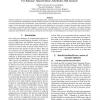78 search results - page 8 / 16 » Determining Word Sense Dominance Using a Thesaurus |
CICLING
2007
Springer
14 years 2 months ago
2007
Springer
Distributions of the senses of words are often highly skewed. This fact is exploited by word sense disambiguation (WSD) systems which back off to the predominant (most frequent) s...
LREC
2008
13 years 9 months ago
2008
Semantic similarity is a key issue in many computational tasks. This paper goes into the development and evaluation of two common ways of automatically calculating the semantic si...
WAIM
2007
Springer
14 years 2 months ago
2007
Springer
Terms used in search queries often have multiple meanings. Consequently, search results corresponding to different meanings may be retrieved, making identifying relevant results in...
SAC
2005
ACM
14 years 2 months ago
2005
ACM
A great jump towards the advent of the Semantic Web will take place when a critical mass of web resources is available for use in a semantic way. This goal can be reached by the c...
SIGGRAPH
2010
ACM
14 years 10 days ago
2010
ACM
In many scenes with human characters, interacting groups are an important factor for maintaining a sense of realism. However, little is known about what makes these characters app...

